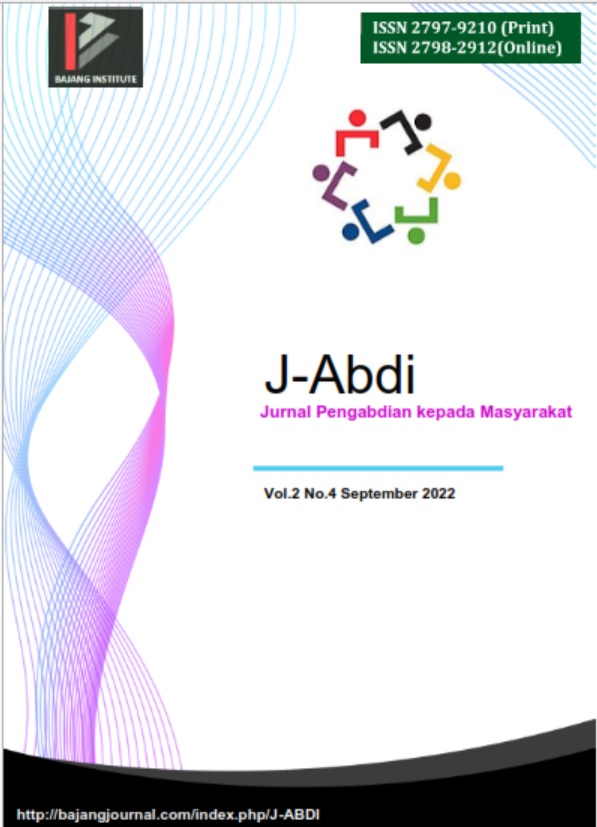CRITICAL THINKING EFFECTIVE EDUCATION RESOURCES MANAGEMENT DURING THE CRISIS OF THE 21st CENTURY
DOI:
https://doi.org/10.53625/jabdi.v2i4.3230Keywords:
Critical Thinking, Educational, Crisis Of The 21st CenturyAbstract
In general, there is a wide gap in the quality of education between education in our country and the quality of education in developed countries, although in some individual achievements at the international level, Indonesian children are able to excel. The wide gap in the quality of education in Indonesia is reflected, among other things, from the results of a study on reading ability for elementary school (SD) conducted by the International Educational Achievement (IEA) organization which conducted a research called Trend in International Mathematics and Sciences Study (TIMSS) in in 1999 which indicated that elementary school students in Indonesia were in 38th place out of 39 countries studied. Meanwhile, for junior high school (SMP) level, the study for mathematics ability of junior high school students in Indonesia was only 39 out of 42 countries studied, and natural science (IPA) skills only ranked 40 out of 42 countries studied. In 2003, the same research was conducted. To catch up with education, the government launched a superior school policy. This policy is expected to be able to improve the quality of education, especially schools. This policy is stated in the Strategic Plan of the Ministry of National Education 2010-2014, namely by doing: 1. Development of local excellence-based schools in each district/city. 2. Construction of quality schools commensurate with international education management in each province/district/city. Before the policy of superior schools proclaimed by the government was set, actually schools that could be categorized as superior schools had been scattered in this country, unfortunately most of them were scattered in big cities. Until 2020, the survey results prove that the State of Indonesia is in 10th place from the bottom with other countries in terms of literacy and science. This article uses library research methods from books and journals, aiming to find out how effective HR quality is in 21st century education unit management.
References
Abdul Jabar, Cepi S.A. 2011. Pencapaian Keunggulan Sekolah. Disertasi.Bandung: Universitas Pendidikan Indonesia.
Amalliah. K. 2021. High Criticism Taking Policies and Developing Effective Education Planning At Boarding Upgraded Boarding School During COVID-19. Mahasiswa Pascasarjana S3 Manajemen Pendidikan. Universitas Negri Jakarta. Vol. 12 Issue 2 of 2021: November 2, 2021. Hlm 1 – 26. ISSN: 0171-4996. Q4. Italienisch.editor@gmail.com.
_________. 2021. Critical thinking, Leadership and Organization in education, health and business During The COVID-19 Pandemic. Mahasiswa Pascasarjana S3 Manajemen Pendidikan. Universitas Negri Jakarta. Vol. 20 Number 2 of 2021: November 2, 2021. Hlm 1 – 16. ISSN: 0376-8163. Q4. asbl.degres@gmail.com.
_________. 2021. Peranan Keteladanan orang Tua dan Pendidikan (Kecerdasan Spiritual, Kecerdasan Intelektual, dan Kecerdasan Emosional). Sumatra Barat: Mitra Cendekia Media.
_________.2022. Peran Pemimpin Dan Kepemimpinan Dalam Perilaku Organisasi Untuk Mewujudkan Manajemen Pendidikan Efektif Era New Normal Dan 5.0-6.0 Dunia. Sumatra Barat: Mitra Cendekia Media.
_________. Inovasi Manajemen Kepemimpinan Era New Normal “Pendekatan Teknologi Pendidikan Dan Strategi Pembelajaran”. Mahasiswa Pascasarjana IAI-N Laa Roiba (Manajemen Pendidikan), Angkatan 2018.
Badan Penelitian dan Pengembangan Departemen Pendidikan Nasional. (2004) RPP: Standar Nasional Pendidikan, Evaluasi, Akreditasi, dan Sertifikasi. Makalah untuk diberi masukan
Badan Perencanaan Penelitian pengembangan Daerah Kota Banjarmasin. (n.d.). Pengertian Perencanaan, Tujuan Perencanaan, Prinsip Perencanaan, filosofi perencanaan Program. In BARENGLITBANGDA.
Djaramah. Syaiful Bahri. 2014. Pola Asuh Orangtua Dan Komunikasi Dalam Keluarga “Upaya Membangun Citra Membangun Pribadi Anak.” Jakarta: Rineka Cipta, hal. 91-92.
Danim, S. (2004). Motivasi Kepemimpinan dan Efektivitas Kelompok (1st ed.). PT. Rineka Cipta.
E. Mulyasa. 2007. Manajemen Berbasis Sekolah. (Bandung: Remaja Rosdakarya, cet. 11.
_________. 2013. Manajemen dan Kepemimpinan Kepala Sekolah. (Jakarta: Bumi Aksara, cet. 3,
Fattah, Nanang. Analisis Kebijakan Pendidikan. (Bandung: Rosdakarya
Fathoni, A. (2006). Organisasi Dan Manajemen Sumber Daya Manusia (1st ed.). PT. Refika Aditama.
Goen, Anggun.Standar Pengelolaan Pendidikan.(http://goenable.wordpress.com/,diakses tanggal 10 Maret 2017)
Hasan, B. (2010). Perencanaan Pengajaran Bidang Studi (4th ed.). Pustaka Ramadhan.
Hersey, P., Blanchard, K., & Dharma, A. (1994). Manajemen Perilaku Organisasi: Pendayagunaan Sumber Daya Manusia (Management of Organizational Behavior: Utilizing Human Resources, 4th Edition). Erlangga.
Mathis, R. L., & Jackson, J. H. (2006). Human Resource Management “Manajemen Sumber Daya Manusia. Penerbit Salemba Empat.
Ornstein, Allan c. and Francis P. Hunkins. 1988. Curriculum, Foundations, Principles, and Issues. (Boston: Allyn and Bacon.)
Permendiknas no. 19 tahun 2007. 2007. Standar Pengelolaan Pendidikan Oleh Satuan Pendidikan Dasar dan Menengah. Jakarta: BSNP.
Pidarta, M. (2005). Perencanaan Pendidikan Partisipatori Dengan Pendekatan System (Edisi Revisi). PT. Rineka Cipta.
Rifa’i, V., & Mulyadi, D. (2009). Kepemimpinan dan Perilaku Organisasi (3rd ed.).
Sukmadinata, Nana Syaodih. 2001. Pengembangan Kurikulum Teori dan Praktek. (Bandung: Remaja Rosdakarya.
Sedarmayanti. (2011). Membangun Dan Mengembangkan Kepemimpinan Serta Meningkatkan Kinerja Untuk Meraih Keberhasilan (1st ed.). PT. Refika Aditama.
Sedarmayanti. (2013). Manajemen Sumber Daya Manusia (Reformasi Birokrasi Dan Manajemen Pegawai Negri Sipil) (13th ed.). PT. Refika Aditama.
Sukmalana, S. (2010). Perencanaan SDM (Konsep, Proses, Strategi dan Implementasi) (1st ed.). OT. Intermedia Personalia Utama.














